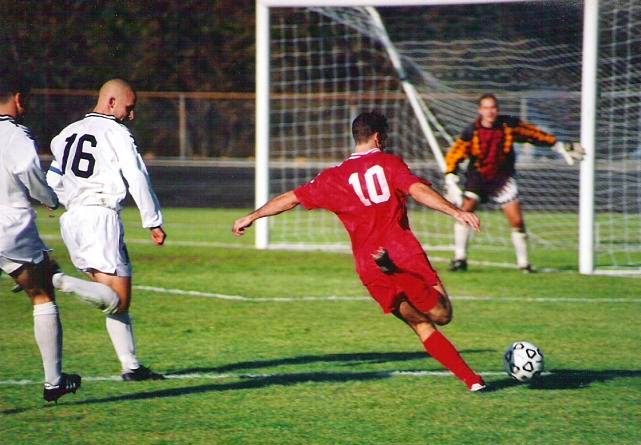 N Engl J Med
N Engl J Med
January 31, 2008; 358:475-483
DOI: 10.1056/NEJMoa0707427
Ute Wilbert-Lampen, M.D., David Leistner, M.D., Sonja Greven, M.S., Tilmann Pohl, M.D., Sebastian Sper, Christoph Völker, Denise Güthlin, Andrea Plasse, Andreas Knez, M.D., Helmut Küchenhoff, Ph.D., and Gerhard Steinbeck, M.D.
Medizinische Klinik und Poliklinik I, Campus Grosshadern, Germany
BACKGROUND:
Events that induce environmental stress in a large number of people in defined areas — such as earthquakes, war, and sporting events — may increase the risk of cardiovascular events. Reports of the association between soccer matches and rates of illness or death from cardiac causes have been controversial.
The Fédération Internationale de Football Association (FIFA) World Cup, held in Germany from June 9 to July 9, 2006, provided an opportunity to examine the relation between emotional stress and the incidence of cardiovascular events.
METHODS:
Cardiovascular events occurring in patients in the greater Munich area were prospectively assessed by emergency physicians during the World Cup. We compared those events with events that occurred during the control period: May 1 to June 8 and July 10 to July 31, 2006, and May 1 to July 31 in 2003 and 2005.
RESULTS:
Acute cardiovascular events were assessed in 4279 patients. On days of matches involving the German team, the incidence of cardiac emergencies was 2.66 times that during the control period (95% confidence interval [CI], 2.33 to 3.04; P<0.001); for men, the incidence was 3.26 times that during the control period (95% CI, 2.78 to 3.84; P<0.001), and for women, it was 1.82 times that during the control period (95% CI, 1.44 to 2.31; P<0.001). Among patients with coronary events on days when the German team played, the proportion with known coronary heart disease was 47.0%, as compared with 29.1% of patients with events during the control period. On those days, the highest average incidence of events was observed during the first 2 hours after the beginning of each match. A subanalysis of serious events during that period, as compared with the control period, showed an increase in the incidence of myocardial infarction with ST-segment elevation by a factor of 2.49 (95% CI, 1.47 to 4.23), of myocardial infarction without ST-segment elevation or unstable angina by a factor of 2.61 (95% CI, 2.22 to 3.08), and of cardiac arrhythmia causing major symptoms by a factor of 3.07 (95% CI, 2.32 to 4.06) (P<0.001 for all comparisons).
CONCLUSIONS:
Viewing a stressful soccer match more than doubles the risk of an acute cardiovascular event. In view of this excess risk, particularly in men with known coronary heart disease, preventive measures are urgently needed.
http://www.nejm.org/doi/full/10.1056/NEJMoa0707427
Thursday, 31 January 2008
Cardiovascular Events during World Cup Soccer






Tuesday, 1 January 2008
What Kind of Erotic Film Clips Should We Use in Female Sex Research? An Exploratory Study
 The Journal of Sexual Medicine
The Journal of Sexual Medicine
Volume 5, Issue 1, pages 146–154, January 2008
DOI: 10.1111/j.1743-6109.2007.00641.x
Terri L. Woodard MD [1], Karen Collins MS, MA [1], Mindy Perez BA [1], Richard Balon MD [2], Manuel E. Tancer MD [2], Michael Kruger MS [1], Scott Moffat PhD [3] and Michael P. Diamond MD [1]
[1] Department of Obstetrics and Gynecology, Wayne State University School of Medicine, 3750 Woodward avenue Suite 200D Detroit, MI, USA 48201
[2] Department of Psychiatry, Wayne State University School of Medicine, Detroit, MI, USA
[3] The Gerontology Institute, Wayne State University School of Medicine, Detroit, MI, USA
Introduction
Erotic film clips are used in sex research, including studies of female sexual dysfunction and arousal. However, little is known about which clips optimize female sexual response. Furthermore, their use is not well standardized.
Aims
To identify the types of film clips that are most mentally appealing and physically arousing to women for use in future sexual function and dysfunction studies; to explore the relationship between mental appeal and reported physical arousal; to characterize the content of the films that were found to be the most and least appealing and arousing.
Methods
Twenty-one women viewed 90 segments of erotic film clips. They rated how (i) mentally appealing and (ii) how physically aroused they were by each clip. The data were analyzed by descriptive statistics. The means of the mental and self-reported physical responses were calculated to determine the most and least appealing/arousing film clips. Pearson correlations were calculated to assess the relationship between mental appeal and reported physical arousal.
Main Outcome Measures
Self-reported mental and physical arousal.
Results
Of 90 film clips, 18 were identified as the most mentally appealing and physically arousing while nine were identified as the least mentally appealing and physically arousing. The level of mental appeal positively correlated with the level of perceived physical arousal in both categories (r = 0.61, P < 0.05 and r = 0.62, P < 0.05). The most appealing and physically arousing films tended to exhibit heterosexual behavior with vaginal intercourse. The least appealing and least physically arousing films tended to depict male homosexual behavior, fellatio, and anal intercourse.
Conclusions
Erotic film clips reliably produced a state of self-reported arousal in women. The most appealing and arousing films tended to depict heterosexual vaginal intercourse. Film clips with these attributes should be used in future research of sexual function and response of women.
http://onlinelibrary.wiley.com/enhanced/doi/10.1111/j.1743-6109.2007.00641.x/





